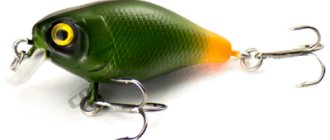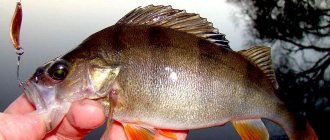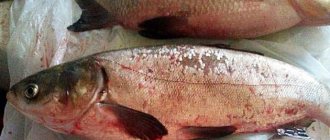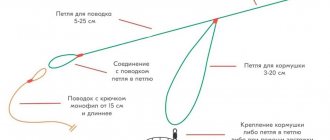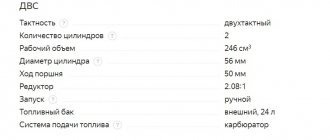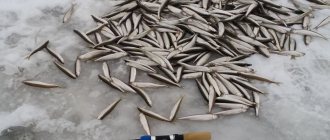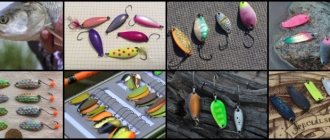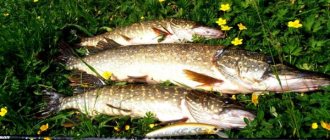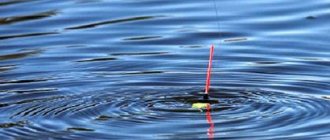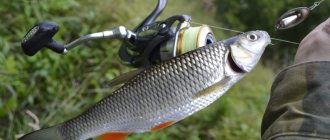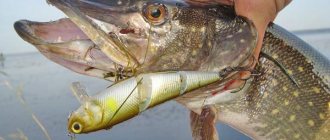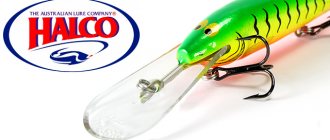Buy quality products at affordable prices in the best fishing online stores
. Give gifts to yourself and your loved ones!
we are in social networks
— subscribe to us on Facebook, Youtube, VKontakte and Instagram. Stay up to date with the latest site news.
Fish such as ide are known for their omnivorous nature. She eats plant foods and small fish equally well. This feature of ide attracts all anglers to it: from floaters to spinning anglers.
Spinning fishing for ide can be successful if you use the right spinners and wobblers. In this article we will not give exact recipes for catching this fish. Let’s just try to figure out the most suitable wiring tactics when fishing for ide. Let's present one of the many versions of the best wobblers for catching ide.
The best models of wobblers for ide (Rating)
- OWNER C'ULTIVA BUG EYE BAIT
. This floating fat belongs to the surface baits. It has a round body with a small blade. The bait has a length of 5 cm and a weight of 6.5 grams. It is intended for fishing in summer and late spring. The working depth of the wobbler is from 0 to 0.5 meters.
- LUCKY CRAFT BEVY PENCIL
. A catchable walker that imitates a weakened fry in the water. The bait has an oblong body with a silver tint. It exactly repeats the outlines of the perched water. The wobbler flies very well. Its length is 6 cm and its weight is 4 grams. Shows the best results with surface wiring in small areas.
- JACKALL ASKA SR
. A nice floating crank that flies far and holds well in areas with strong currents. The wobbler has a medium-sized blade located at an angle. Thanks to his high body and shoulder blade, he shows a good game, while rarely clinging to stones and snags. The bait is made in three dimensional modifications: lengths 4.5, 5.6 cm with weights 4.6, 7, 11.6 grams. Immersion depths of wobblers: 1-1.2, 1.2, 1.5 meters.
- JACKALL ASKA MR
. Another catchy crank, which is similar to the previous model. It is distinguished by a larger blade, which gives the bait its own game. The wobbler is suitable for uniform wiring and twitching. Its length is 4.5 cm, weight is 5.7 grams. Working depth – 1.8 meters.
- RAPALA GLASS SHAD RAP
. A shad-type wobbler is designed for fishing in wide water areas with great depths. This translucent bait creates noise when baited, which should attract the ide. The bait has a very long blade. The immersion depth is 1.5-5 meters. The wobbler is made in three modifications with lengths of 4.5.7 cm and weights of 5.9 and 12 grams.
- Incubator Max 030
. A surface wobbler with a diving depth of up to 30 cm is used for fishing in overgrown reservoirs with and without a slow current. The length of the bait is 5 cm, and the weight is 6 grams.
- ZIPBAITS B-SWITCHER 2.0
. A floating wobbler with very good flight characteristics. It has a long blade and a tall body. The length of the bait is 5.5 cm, weight is 10 grams. The working depths of the wobbler are 1.5 – 2.3 meters.
- TACKLE HOUSE BUFFET BUMU – 50
. The fast-sinking wobbler is equipped with two hooks and has an elongated body. Suitable for long casts and step retrieving. The blade is located at a large angle to the mouth, which makes the bait very mobile in the water. Wobbler length – 5 cm, weight – 5.5 grams. Working depth - up to 0.6 meters.
- LUREFANS CC50S
. Sinking shad is suitable for catching asp in medium and fast currents. It has a medium-sized blade located at an angle. The length of the bait is 5 cm, weight is 7.5 grams.
- JACKALL CHUBBY
. Fat, designed for fishing in the current. It has a wide blade and a memorable appearance. It features high-frequency action and is suitable for catching medium and small ide. The length of the bait is 3.8 cm, weight is 4 grams. Working depths are from 0.5 to 1 meter.
Catching chub and ide with silicone baits
Date: December 16, 2015 | 513
Such river semi-predatory fish as chub and ide have quite confidently entered the catches of spinning fishermen. But, basically, these fish are caught with ultralight spinning rods using wobblers, rotating and oscillating spoons. But what about catching these types of fish with soft baits and edibles? We will deal with this issue in this article. So, can chub and ide be caught with silicone and what place do such baits generally occupy in catching these river fish?
Chub and ide are considered semi-predatory fish. They feed on insects, various bottom living creatures, as well as fish fry. These fish are successfully caught with donks using worms, bloodworms, and steamed peas. Also, fly fishing or boat fishing with artificial flies or real insects. And, more recently, on the right spinning baits: small wobblers and spinners.
Chub and ide are inhabitants, first of all, of rivers and streams. These are small rivers, a couple of tens of meters wide, and large, basin-forming rivers.
From early spring, these fish feed at the bottom. In late spring, with the appearance of insects, more and more gravitate towards the surface. Large individuals stay slightly lower, in the water floor, but are also oriented towards the surface. With the onset of autumn cold, chubs and ides again descend into the lower layers, tending to holes and channel depths.
So, in early spring and mid-late autumn, ide and chub can be caught near the bottom, with a jig or spaced-out rigs, such as a drop-shot, or a retractable leash. The problem is that almost no one catches these fish with a jig spinning rod on purpose. Yes, when fishing for river perch, or pike perch, or pike, chub and ide bites occur. Such bites most often occur in fairly deep sections of rivers, near steep banks, at turns, on the slopes of the bank edge, where the riverbed begins to rise towards the shore, especially where many fallen trees lie in the water, hanging over the water.
Alas, I won’t undertake to give advice on how exactly to make a chub or ide the main trophy when fishing with jig. We can only recommend how to increase the likelihood of catching these fish, so to speak, to increase the chances without cutting them off or scaring them away.
Well, firstly, the size of baits should not be in the region of 1.5”, 2”, 2.5”. If we put a 3” bait, then consider that we are already cutting off more than half of the chances of biting chub and ide. The medium compartments are almost zero, the large ones are not so much, but still.
Secondly, the silicone must be equipped with a fairly light weight. This gives smoother movements, and the sinker itself does not scare off cautious river fish. The problem is that a light jig cannot always be used in those places where it is optimal to look for ide and chub. There is generally quite a strong current and not shallow. This is why, where conditions permit, we use the lightest jig. Where not, we use spaced rigs (retractable, drop-shot). We hold the bottom with a heavy sinker and walk along it. And the bait and hook are a little higher, they play freely.
Thirdly, the wiring should not be very sharp. The steps of the bait should not be too long and, if possible, smooth.
Fourthly, the installation should be elegant, all elements should be as thin and small as possible (the thinnest possible cord, fishing line, accessories to a minimum and the smallest, thin hooks). Between the bait and the cord there should be a leash made of the thinnest fluorocarbon, at least 1.5-2 m long.
It is clear that the fourth condition goes very poorly with pike fishing when a metal leash is needed. Also, it is difficult to fish in snags and not have, in fact, the opportunity to counter the strength of the tackle to the hook... But these are the realities. Chub or ide, sometimes, take silicone on a rather rough rig designed for pike, with a thick iron leash and a powerful cord, that’s all. But this is not a reason for joy. This means that the chub showed great activity at that moment. Meanwhile, 9 out of 10 opportunities were missed due to poor tooling. There were simply no bites and we didn’t find out about them.
The type of bait can be absolutely any. Chub and ide are caught on small vibrating tails, twisters, slugs, artificial worms, silicone crayfish, and all sorts of insect imitations. Colors are of great importance if fishing occurs in early spring, in muddy water. Then bright colors that are clearly visible in dark water work better for chub and ide: white, bright yellow, lemon, caustic salad, orange, various contrasting combinations. In clear water, on the contrary, it is better to give preference to dark colors, or translucent, cloudy ones.
Of course, for fish such as chub and ide, it is better to use baits made of soft, richly attaracted edible silicone rather than regular ones. It happens that even regular silicone of the previous generation bites, but edible stuff is noticeably better! Even predators do not react as strongly to the difference between edible and inedible rubber as these fish.
Let me remind you that all of the above applies to periods when chub and ide stick to the lower layers of water. This continues throughout early spring, throughout late autumn, and also happens sporadically throughout the summer, depending on the weather.
Yes, along with jigging for perch, pike perch, and pike, you can catch not only ide and chub, but also asp.
Next, let's talk about how to catch chub and ide with silicone baits, with edible bait in the summer, late spring, early autumn, when these fish gravitate to the middle and upper layers of water.
Yes, and in the summer I had the opportunity to catch chubs using jig baits designed for pike. But, this is all from the category of accidents, the convergence of stars and celestial bodies...
More targeted fishing is possible using special silicone baits specifically designed for fishing from the surface or in the near-surface layer.
We are talking about small-sized, no more than 1.5-2” (up to 5cm) baits made of floating silicone, which imitate various insects, beetles, flies, dragonflies, grasshoppers, etc. Examples of such edible models include: Bait Breath Bj-Bug, Bait Breath Dra Fla, Bait Breath IMP level 2, Reins Insecter and the like.
The fisherman is armed with the lightest ultralight spinning rod. A bait imitating an insect is placed on the hook without additional weight. Moving in a drifting boat along a promising shore, at some distance from it, the fisherman throws a silicone imitation at the edge of the water and shore, under overhanging bushes, trees, in niches on steep banks, and among snags. Often a chub or ide attacks the bait presented in this way immediately, on the splash. Or, you need to make some kind of wiring, imitate the movements of an insect that has fallen on the surface of the water.
I think there is no need to say that the thinnest fishing line or cord should be used, with an elegant UL spinning rod... Well, and a long leash made of thin fluorocarbon is a mandatory element of such equipment.
There is a period when chub and ide actively feed on flying insects, this method of fishing with silicone is relevant. Sometimes, this method is in no way inferior to fly fishing or fishing with shallow water mini-wobblers.
So, as we see, catching ide and chub with silicone baits and edible bait is possible! With a greater or lesser degree of purposefulness, but perhaps! You just need to find the right approach, assemble the right tackle and choose a serving strategy, depending on the conditions.
Share with your friends:
Categories: Fishing for food · Tags: Chub, Places, Lures, River, Food, Equipment, Ide
How justified is it to catch ide with a wobbler?
Spinning fishing is most often done with spinners. However, this in no way reduces the importance of wobblers. They often catch the largest fish. In what situations is it better to fish with wobblers? Firstly, this is night fishing. Only chub and pike perch have an advantage in this type of fishing. At night, ide takes well in shallow waters near the coastal zone. Naturally, surface wobblers are suitable for such fishing.
It is good to catch ide using a wobbler using the rafting method at depths of 3 to 4 meters. Such fishing leads to good results if you fish in the daytime or evening. It is better to use wobblers with a long blade that touch the bottom during wiring.
A special feature of catching ide with a wobbler and other baits is the desirable absence of perch, chub and pike in the fishing zone. Why desirable? The fact is that almost all offered wobblers are included in the area of interest of the above-mentioned fish. The same chub, for example, quickly navigates the terrain and is more willing to take a fallen wobbler, leaving no chance for the ide.
Therefore, it is necessary to choose, if possible, places in which ide predominates. Or find baits that are of little interest to asp, pike, chub, and mostly ide.
Where to catch ide with a spinning rod
Experienced fishermen know that it is very difficult to outwit him; all the senses of this fish are perfectly developed; he sees, hears and smells perfectly. Despite the fact that it usually feeds on larvae, insects, worms, algae, it is not averse to eating small fish, partly it is a predatory fish. And therefore, they can be caught with a spinning rod on the river at certain times in the spring, even more than with a float rod, feeder or donk.
Although it is usually not possible to catch an ide on a spinning rod often, mainly when it fattens in the spring and autumn, most of them are caught by roaches and even a chub or asp can be caught more often. Typically, tongues, unlike chubs, stick to depth and are found near the bottom in pools, muddy holes, and often in snags. In the summer when fishing, catching an ide on a spinning rod is more likely to be a random bite when catching a perch, chub or asp.
The best time to catch ide with a spinning rod during the day is in spring and autumn, when the fish is fattening and moving around in search of food. In the summer, fishing for ide with a spinning rod is less successful since this fish at this time of year feeds mainly at night and at this time it is better to catch ide with a feeder or donk. And yet, in the early morning or late evening, as well as when they melt, casting brings results; roaches are mostly caught on wobblers.
Properties of wobblers for ide
What are the best wobblers for catching ide? Firstly, they must have a unique game, with a lot of vibrations, but with a small amplitude. Secondly, the blade and immersion depth of the bait must correspond to the depth at the fishing site. If, for example, there are a lot of perch in the fishing area, and we move the bait so that the blade touches the bottom, then it is the perch that will take it. It is better to avoid places where this predator gathers. It can be annoying, like rotan, when you catch crucian carp or other white fish.
For catching ide, wobblers measuring from 3 to 7 centimeters are best suited. They also catch larger ones, but mainly in the fall, when the time comes for intensive hunting for small things. In addition, large baits allow you to cut off smaller contenders.
Which wobbler is better in terms of buoyancy? It can be sinking, floating or composite. But most often fishermen use floating models. Regarding the color of baits, no preferences of ide were noticed in this regard. It successfully attacks bright shiny wobblers and lures of natural colors.
When fishing for ide, it is better to always have long-flying wobblers in stock. As you know, ide adheres to careful tactics of behavior and hunting for fry, so it has to be caught at long distances. The bait is often thrown 30 meters or more.
If we talk about specific types of wobblers, cranks and fats are considered the best. Fishermen choose Japanese models as the most catchy ones. Although now more and more new manufacturing companies are appearing, producing good analogues, which in many respects are not inferior to well-known wobblers and cost reasonable money.
When buying wobblers, it is better to take models with several modifications: with different immersion depths and different buoyancy. This way you can fish the area over the entire horizon.
A sinking wobbler is good for step-by-step retrieving. Floaters tend to perform better. In some cases, the ide takes at a depth of 3 meters, while in others it “agrees” to take the bait, which is taken at a depth of 20 cm.
It is a mistake to think that only small ides and roaches bite on small crank wobblers. This is wrong. Small baits and 2- and 3-kilogram individuals are attacked. It is not clear why they are so attracted to such wobblers, but this fact has been confirmed by many spinning anglers.
Wobbler selection
Floating wobblers of black and yellow-green color with three-dimensional eyes, about 50 mm long, are of genuine interest to ide in the summer. The ide is especially partial to such bait during twitching. It will also appeal to anglers who come for fishing, not only to fish, but also to actively spend time while playing with bait.
When the ide is near the surface of the reservoir, surface wobblers - a class of 60 mm long wobblers - work great. During such wiring as a “walking dog”, a surface wobbler creates peculiar vibrations on the surface of the water, simulating a weak fish and provoking an ide to attack.
For fishing in small rivers, a small surface model is used - about 32 mm, capable of going down to 0.8 m. This floating bait holds well in the current and is cast far.
In deep water, it is necessary to use a deep-plunging wobbler for catching ide with a length of 40-70 mm, capable of diving to a depth of 1.5 - 4.5 meters. An excellent addition would be the noise effect of the bait. Such wobblers work best when twitching.
If you plan to fish in thickets, in still waters or with a small current, it is better to use surface wobblers about 50 mm long. The wiring should be carried out evenly, slightly accelerating in places with greater depth.
General principles of selection
When choosing wobblers based on ide, you must adhere to some general principles. The bait must have an intense and active game. It is better to catch ide with floating models of wobblers. It is better to have baits with different diving depths. Depending on the water layers in which fishing is carried out, the working depth of the bait is selected. It is also necessary to take into account that when retrieving the tackle should not touch the bottom. The size of the wobbler should be between 30-70 mm. Given the wariness of the fish, the bait should be suitable for long casts. The color of the bait does not have a significant effect on the fish bite, but it is better to give preference to wobblers of soft colors.
Promising places for catching ide with wobblers
What places are best suited for fishing for ide with a spinning rod and wobblers? First of all, of course, rifts with depths from 4 to 6 meters. The river turns are very promising. It’s even better if the shore is concave, as in the image:
If we take this example specifically, the promising area is located behind the reeds, right there the river turns. The depth there is normal. The bottom in such places is usually sandy with silt and with a large number of crustaceans and mollusks - food for ide and other white fish. If there is still algae at the bottom and the current is not too strong, then this place can be considered ideal for fishing ide with a wobbler.
Another promising location is an area with fallen trees with little or no current. If the trees have been in the water for a long time, it means that all underwater inhabitants are accustomed to it, including fish. It is very good if there is a hole near the tree. It is in them that the ides live. True, it will be more difficult to catch them than on the rifts.
And finally, the third promising place is a quiet reach with variable depths from 2 to 4 meters. There must be algae at the bottom so that they do not rise to the surface of the water.
Lures, wobblers and spinners for ide
To catch ide with a spinning rod, wobblers and spinners can work and be catchy in different colors; it is necessary to take into account the size of the bait, since the mouth of the fish is not as large as that of pike or pike perch, then the bait should not be large, 2-4 in length cm.
And also, taking into account the ulcerous parking areas, it is better to select the depth of the wobblers in such a way that when retrieving they go near the bottom. Lures for ide are mostly dark in color; bright acid colors hardly work when fishing, this is probably due to its food supply, what it likes to eat. In order to better choose a bait, spoon or wobbler for ide, you need to study the lifestyle of these fish and their habitats, what time of year, and what they like to eat.
Spoons also work well when catching ide on a spinning rod; oscillating and rotating spoons are suitable. Spoons, spinners for ide and roach are usually also not large in size, 2-5 cm in length, preferably dark or spotted colors, similar to gudgeon. And the pinwheels are small in size, 1-2 numbers, with petals of various shapes and colors. It is difficult to please these fish, but given the variety of food that they are used to eating, it is possible to choose a spoon.
Any fisherman knows that when fishing you definitely need to try different baits; sometimes some unsightly and cheap spinner or wobbler will be preferable to an expensive bait from a well-known manufacturer.
This is a cautious and timid fish, so to cast bait it is better to approach from below the river and throw a spoon or wobbler upstream or across the river. Although when fishing for ide with a spinning rod, if you fish holes and pools, then casting bait downstream also works, for the reason that, unlike the chub, it stays closer to the bottom.
Tackle for catching ide with wobblers
If we fish from a boat, we use medium-class rods 2.1-2.4 meters long with a test weight of up to 18 grams and a sensitive tip. In this case, the rod should “hold” the fish well. This is especially true when fishing among trees, when you have to fight with a predator so that it does not take the bait into snags.
We attach a reel to the rod with a spool capacity of 2000 and 0.12-0.14 mm braid. You can also use rigid monofilament fishing line with a diameter of 0.2 mm. Metal leashes are usually not used when fishing for ide, since it cannot bite through fluorocarbon ones. You can do without leashes at all if you are sure that there are no pike nearby. When fishing from a boat, be sure to use fishing rods with reliable latches and thick wire.
Wobblers for chub: TOP 10
YO-ZURI L-Minnow 44
My TOP 10 opens with a truly legendary bait, without which not a single rating of wobblers for catching chub and ide is complete.
The 44 cm sinking wobbler has phenomenal flight characteristics and exceptionally stable play even in strong currents. Moreover, this wob plays like a crank, so the name does not quite correspond to reality.
L-Minnow 44 literally mows down chub; in a good place, in a day, you can earn several dozen bites. Most often, chubs and ides weighing up to 1 kg bite on the wobbler, but sometimes heavier specimens also attack it...
There is another model in the L-Minnow line, measuring 33 mm. It is also quite working; white predators and trout are also caught well with it. However, the 33rd is inferior to the 44th in catchability. So, the rule “the smaller the bait, the more bites” is not always true.
You can buy L-Minnow 44 for about 400 rubles. I recommend it to anyone who dreams of catching their first chub. This wobbler will make your dream come true in no time.
Wobblers for chub - Smith Camion
A typical pot-bellied crank, with good flight characteristics and very active, high-frequency play. Developed by Japanese engineers for targeted trout fishing.
It must be said that in his homeland, he is considered one of the best in his specialization. Here, Kamion works exceptionally well on chub from May to September.
With its appearance, this wobbler imitates a large insect that accidentally fell into the water. It is often attacked by chub at the moment of splashdown, as well as when it plays in one place under the influence of the current.
The cost of Camion reaches 1000 rubles. Still, a purebred Japanese who is really worth the money. However, not everyone is ready to pay that kind of money for a plastic bait...
Due to its exceptional catchability, Camion quickly came under the radar of manufacturers specializing in the production of replica wobblers, so there are many replicas of this crankbait on the market. For example, Kosadaka Roger or Tsuribito Baby Crank. They work no worse than the original, but cost one and a half to two times less.
Salmo Hornet
Another chub classic. In sizes of 2.5, 3.5, and 4 cm, this wooden crank perfectly seduces chub, and in different conditions. Hornet works effectively in shallows, but at the same time it bites well in calm water. Small and medium-sized chub, as well as ide, are simply crazy about them!
These wobblers for chub cost about 200 rubles, so “Honetics” are available to almost all anglers.
Tsuribito Mushi
Not expensive (400-450 rubles), but a very high-quality and catchy wobbler, made in the shape of a beetle. Specifically, it is very reminiscent of a beetle, so Mushi is simply irreplaceable in May, when the mass emergence of this insect begins, and the chub begins to intensively eat individuals that have fallen into the water
In order for chub fishing with a wobbler to be productive, it is necessary to deliver it to the fish’s resting place either by rafting or by light pendulum casting.
“Wobblers for chub”
The attack occurs either immediately after the bait touches the surface of the water, or while playing along with the tip of the rod. And only in isolated cases does a chub grab the bait on the line itself. Mushi is effective in spring and summer. In the fall, baits of this type become useless.
River2Sea Sea Beeti Cranck
Another very beautiful beetle that works great on chub in the warm season, when the red-finned predator stays in the upper layers of the water and feeds on insects falling into the water from overhanging tree branches.
"Wobblers for chub"
Fishing the Sea Beeti Cranck is the same as the Tsuribito Mushi: focus on the presentation rather than the retrieve itself. The detailing is done at the proper level; it is practically indistinguishable from a real beetle.
Therefore, fishing with float or splash wobblers can be almost as effective as fishing with live bug bait. The cost of the bait is about 500 rubles.
Pontoon 21 Red Rag
If I were to make a TOP of the most stable wobblers, then, undoubtedly, Red Rag would be in the first positions. This wobbler does not lose its play even in very fast currents, so it is simply ideal for fishing in riffles. Riffles, as you know, are the favorite stopping places for chub.
He stays here in spring, summer, and autumn. By the way, it is much easier to catch a chub on seething streams than in any other place.
The cost of Red Rag varies between 550-650 rubles. By today's standards, this is not very expensive. Moreover, the quality of the bait fully corresponds to the price.
Jackall Chubby
Along with the YO-ZURI L-Minnow 44 and the Smith Camion, Chubbick consistently ranks among the top 10 lures for chub. It would be a crime not to include it in my TOP. This wobbler gave me many exciting fishing trips and great trophies.
Due to its good stability, I use it mainly for fishing on riffles. But even in areas with slow currents, this wobbler also perfectly seduces chub.
Interestingly, Jackall Chubby often becomes prey for perch and pike. You need to be prepared for the fact that on the next trip the bait will remain in the toothy mouth.
As for the price, it varies between 650-700 rubles.
Strike Pro Baby Pro
The smallest of 10 wobblers. If you are not chasing the size of the fish, and you want to get the maximum number of bites, the Baby Pro is what you need.
The small size, as well as the high-frequency, “buzzing” game provokes even very small chubs to attack. This is my personal secret weapon that I use on my worst days.
I am always 100% sure that by installing Baby Pro, I will definitely get away from zero. What’s most interesting is that the price of this “miracle” is only 120-150 rubles, but in fact the “Kid Pro” is one of the most catchy chub wobblers. So price doesn’t always “decide”...
YO-ZURI Hardcore 1
This wobbler is not only included in the TOP of the best for pike and large perch, but also in this rating. No, this is not a mistake. Hardcore 1 is a formidable weapon for hunting trophy chub and ide. I discovered by chance that white predators like this wobbler.
When fishing for pike in the fall, I often came across large chubs, and I decided to start using Hardcore specifically for catching this fish. The results exceeded all expectations!
I advise you to follow my example. In the habitats of large chub, you will definitely achieve good results. Cost: 600-700 rubles.
Wobblers for chub: Vinnitsa tadpole
Krenk, which was made with his own hands by one Vinnitsa master - A. Borovichuk. The first tests showed that the bait has excellent flight characteristics, holds even a strong stream well, and its high-frequency yoke drives chubs, ides and small asps crazy.
Wobblers began to be produced in small batches and sold to spinning anglers. Soon, the super catchy tadpole became a living legend, which all amateurs and professionals of chub hunting wanted to get.
At the moment, you can still find original products from Borovichuk on sale. However, they are extremely rare and cost more than the coolest serial “Japanese” ones.
But it’s not problematic and quite affordable to order “Bug” wobblers. This is a small Ukrainian company that mass-produces handmade wooden rolls. The price of Tadpoles from this company is 300-400 rubles, and the quality and performance characteristics are exactly the same as the original products.
